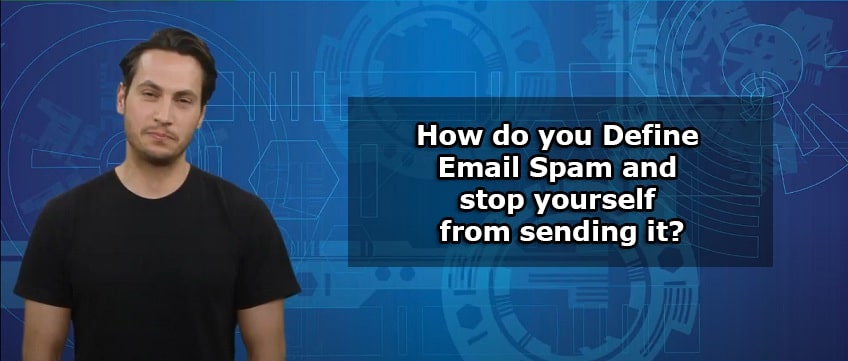So, How do You Define Email Spam?
Spam, the electronic version of junk mail, is something that everyone who has an inbox has encountered at some time. However, when you begin to study business marketing, you may have certain concerns about:
- The definition of spam has been elusive.
- How do email servers determine which messages are spam and which aren’t?
- How can I tell if I’m sending spam email? What is Email Spam?
Please find below detailed explanations to these and related inquiries.
What is Email spam: a brief introduction
To define email spam, let’s start with a definition of spam and what it isn’t. That is to say, the recipient of the email did not actively seek out the content it contained. It’s a communication that went out at the same moment to a large group of individuals.
Have you, for instance, ever received an email from a company but forgotten how you ended up on their list? That particular message may or may not have any bearing on your life. According to this definition, a communication is spam if the recipient does not actively request its receipt.
But the actual meaning of spam differs from person to person and company to company. Due to the rapid development of email marketing, the traditional definition of spam has also become essentially obsolete.
What role spam email plays in the modern marketing landscape
Despite spam email’s bad reputation in the marketing world, it is a common strategy for reaching out to new people and perhaps expanding one’s clientele. Considering there are already over 7 billion email accounts and 95% of users check their email at least once each day, it’s safe to say that email is here to stay. Therefore, it is crucial for a marketer to comprehend its applications.
Spam emails are like junk mail for your inbox. It’s possible that you get several pieces of unwanted direct mail every week. It’s possible to send out many different kinds of direct mail, such as periodicals, brochures, letters, and promotional offers.
Sometimes you can place the sender. Sometimes it is, however. It’s not uncommon to throw away junk mail that contains advertisements. Sometimes you just skim the headlines, but if anything catches your eye, you read the whole article or take the suggested action.
In the same vein, these missives are just as applicable to emails. Daily, you undoubtedly get a large number of promotional emails that you promptly trash. But every once in a while, you get an email with a subject line that really grabs your attention, and you end up clicking on it, regardless of whether or not you know the sender as someone you’ve previously given your email address to.
Email users, in contrast to those who rely only on snail mail, have to be on the lookout for scams like phishing. Whether you bought the user’s email address from a trustworthy data provider or the user signed up for your list on their own, you should always take care to generate clear, simple communications for them.
Electronic Email Spam Filters & How They Sort Emails?
Unlike mailboxes, technology can sort incoming correspondence for us. The inbox and a separate spam or rubbish folder are two of the most common organizational tools provided by email services.
Providers use robust filters and anti-spam technologies to safeguard your primary mailbox. All incoming email gets screened by an AI before it gets sent to the user’s inbox.
ISP-created filters evaluate things like the subject line, the body, and the sender to determine the most appropriate destination for your email. There is a spam filter that automatically moves messages that include anything that may be interpreted as speculation to the spam folder.
That’s why, even if you’ve specifically asked a business to contact you, their communications may still wind up in your spam folder. If you add a firm you really like to your email contacts, however, your email service will begin prioritizing communications from that company and delivering them directly to your inbox.
Some customers use a separate email account just for spam. This is in addition to the built-in spam filters provided by their email service provider. Thus, when they join a loyalty program or, provide their email address to earn a discount, the messages are sent to a secondary mailbox.
In addition, users may mark messages that arrive in their primary mailbox as spam. What this means is that the real definition of spam varies. As, its up to individual users and email service providers to decide what constitutes spam.
The Reality About the Emails That You Send
Now that you understand the definition of spam, how can you tell whether the emails you’re sending fit into that category?
The email marketing cardinal rule used to be that you should only contact those who had requested your communications. These are folks who have explicitly shown their interest in receiving your messages by providing you with their email addresses.
In spite of this, email has seen significant development since its introduction to the public in the 1990s. And so have the methods used by corporations to advertise to customers through email.
In addition, customers may quickly and easily stop getting communications from any company they don’t like. The practice of purchasing email contact lists to reach out to new audiences is therefore becoming more prevalent.
Email marketing is similar to direct mail in that some recipients of your carefully curated list will read and respond to your message while others will ignore it. If you maintain communication with your mailing list and work to refine your email marketing strategies, you may expect to see comparable results whether you acquire your contacts voluntarily or involuntarily.
How then can you be confident that the email list you acquired was obtained lawfully?
Acquiring Email Contact Lists
It’s simple to get a high-quality email list that will pass through spam filters unnoticed. Assuming, of course, that you deal only with a trustworthy vendor.
Firstly, when looking for a reliable list building partner: check their reputation on sites like Reseller Ratings or Google. If you’re looking for a big data organization, be sure they can assist in developing a very specific list. To do this, they must include thousands of different options for narrowing search results, such as a user’s ZIP code, the size of the firm, the number of executives on staff, the number of children in the home, the number of pets, and the user’s interests and/or hobbies.
Only by using search selections can you be confident that the email list you’re building consists of businesses and consumers in the United States who could be interested in what you have to offer. In addition, this implies that when you start sending out marketing emails to the addresses on your bought email list, you’re far more likely to reach real people who could be interested in working with you, rather than just spam traps.
You’ll have less of a chance of being banned if you use lists from a trustworthy big data business. However, avoiding blacklisted emails is possible with the help of a trustworthy data partner. They should be committed to openness and ethics in data gathering.
Don’t be shy about asking a huge data firm about their satisfaction guarantee, either. In reality, data is dynamic. Therefore, it is possible that you may encounter undeliverable addresses or outdated contact names. Irrespective of the big data business you choose to get your email lists from accuracy may be low. Nothing unusual here.
Last but not least
In recognition of the above facts, a credible data supplier offers clients means to set things right. Often, in the form of a satisfaction guarantee. Never get an email list from a firm that does not stand behind its services. Contact us today and discuss your impending email data list requirement with a data list expert.



